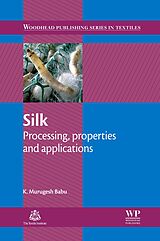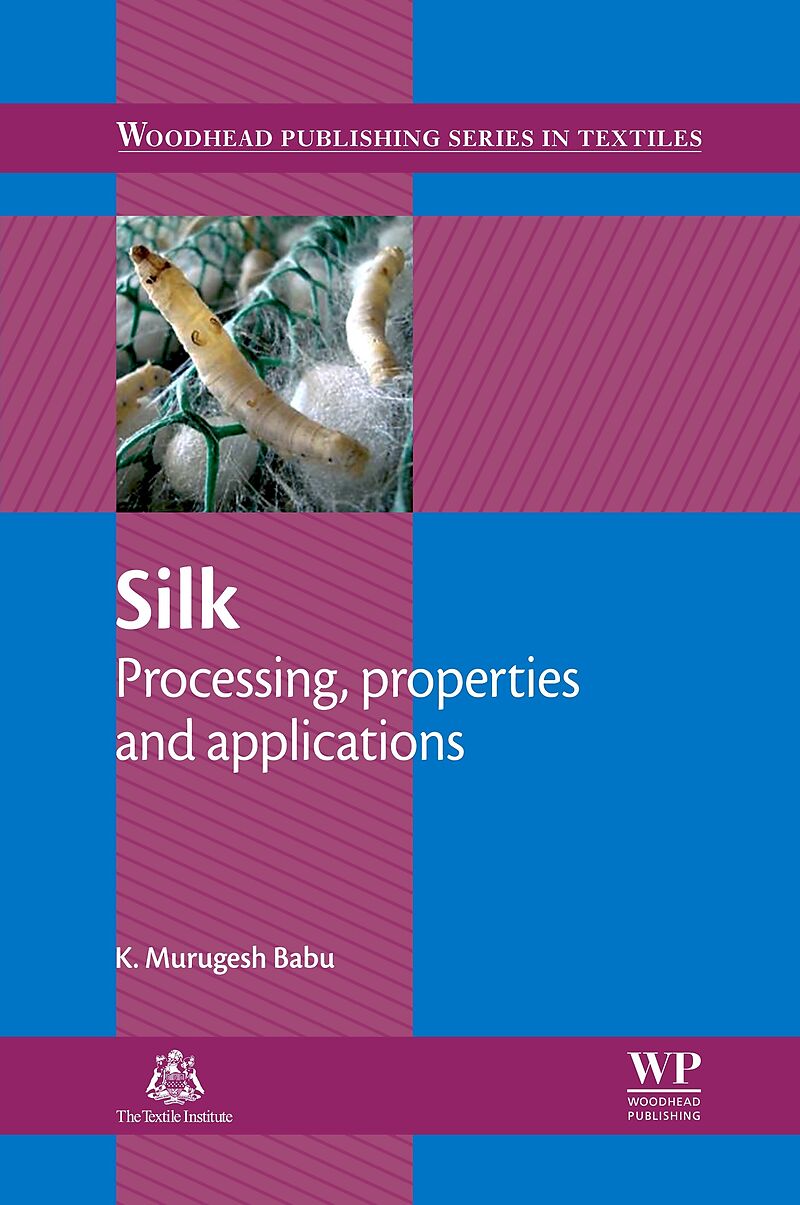Silk
Format:
E-Book (EPUB)
EAN:
9781782421580
Untertitel:
Processing, Properties and Applications
Genre:
Technik
Autor:
K. Murugesh Babu
Herausgeber:
Elsevier Science & Techn.
Anzahl Seiten:
200
Erscheinungsdatum:
31.07.2013
Silk is a natural, environmentally-friendly fibre with a remarkable range of properties, making it ideal for use in apparel and many other applications. Silk: Processing, properties and applications provides an authoritative reference on sericulture, silk fabric processing, silk properties and its applications.
The book begins by looking at key aspects of sericulture, including the range of mulberry and non-mulberry species of silk worm, early and late stage rearing and harvesting of cocoons. Further chapters discuss reeling, weaving and spinning techniques as well as dyeing. The book also discusses the physical and chemical structure of silk as well as its mechanical and thermal properties. Concluding chapters discuss developments in applications and the properties of spider silk.
Silk: Processing, properties and applications is useful for textile technologists, fibre scientists and all those with an interest in the characteristics of silk, its production and the varied uses of this important fibre.Provides an in-depth summary of silk production, properties and structure-property relationshipsExamines the future of silk, including its application in the textile, biomedical, pharmaceutical and cosmetic industriesProvides an authoritative reference on sericulture, silk fabric processing, silk properties and its applications
Autorentext
Dr Babu is Professor and Head of the Department of Textile Technology, and Dean (Public & International Affairs), at the Bapuji Institute of Engineering and Technology (BIET), Davangere, Karnataka, India. Dr. Babu has been involved in several international assignments. In 2006, he was invited to the University of Oxford in the UK, to join a 1-year research project on silk based biomaterials. From 2007 to 2008, Dr. Babu was involved in advanced research on shape memory textiles and garments, at the Institute of Textiles and Clothing, Hong Kong Polytechnic University, Hong Kong. In 2014, Dr. Babu was awarded with the prestigious Commonwealth Fellowship by the Association of Commonwealth Universities, based in the UK. Under this fellowship, he was invited to become a Visiting Professor at the University of Maroua, Cameroon, Central Africa, in order to establish and develop the Department of Textiles. His main research areas include silk-based biomaterials, natural fibre based eco-biocomposites, eco-friendly processing, organic cotton processing and eco-management concepts, natural anti-microbial agent based finishing of cotton and other fibres, and bamboo-blended fabric production and characterization.
Inhalt
Woodhead Publishing Series in Textiles Chapter 1: Introduction to silk and sericulture Abstract: 1.1 Introduction 1.2 Mulberry silk species 1.3 Non-mulberry silk species 1.4 Types of mulberry and moriculture 1.5 The life cycle of the silkworm 1.6 Early age rearing of silkworms 1.7 Late age rearing of silkworms 1.8 Handling of spinning larvae and harvesting of cocoons 1.9 Diseases of silkworms 1.10 Physical characteristics of cocoons 1.11 Trends in sericulture Chapter 2: Silk reeling and silk fabric manufacture Abstract: 2.1 Introduction 2.2 Silk reeling 2.3 Types of silk reeling machines 2.4 Types of silk yarn 2.5 Key steps in silk fabric manufacture 2.6 Weaving of silk fabrics 2.7 Types of silk fabric 2.8 Spun silk production 2.9 Future trends in silk production Chapter 3: Structural aspects of silk Abstract: 3.1 Introduction 3.2 Composition of silk 3.3 Amino acid composition 3.4 Moisture regain 3.5 Microstructure of silk 3.6 Chemical structure of silk 3.7 Crystalline structure of silk 3.8 Optical properties of silk Chapter 4: Mechanical and thermal properties of silk Abstract: 4.1 Introduction 4.2 Tensile properties 4.3 visco-elastic behaviour 4.4 Dynamic mechanical behaviour 4.5 Thermal behaviour Chapter 5: The dyeing of silk Abstract: 5.1 Introduction 5.2 Types of dye used for silk 5.3 Factors affecting dyeing behaviour 5.4 Preparation of silk for dyeing: degumming 5.5 Bleaching of silk 5.6 Dyeing of silk with acid dyes 5.7 Dyeing of silk with reactive dyes 5.8 Dyeing with direct colours and natural dyes Chapter 6: Developments in the processing and applications of silk Abstract: 6.1 Introduction 6.2 Processing of silk fibroin 6.3 Silk non-wovens 6.4 Fluorescent silks 6.5 Biomedical applications of silk 6.6 Silk fibre-reinforced composites 6.7 Conclusions Chapter 7: Spider silks and their applications Abstract: 7.1 Introduction 7. 2 Types of spider silk 7.3 Chemical composition 7. 4 Amino acid composition and molecular structure of dragline silk 7. 5 General properties of spider silk 7.6 Tensile properties of spider silk 7. 7 Applications Index

Leider konnten wir für diesen Artikel keine Preise ermitteln ...
billigbuch.ch sucht jetzt für Sie die besten Angebote ...
Die aktuellen Verkaufspreise von 3 Onlineshops werden in Realtime abgefragt.
Sie können das gewünschte Produkt anschliessend direkt beim Anbieter Ihrer Wahl bestellen.
Loading...
Die aktuellen Verkaufspreise von 3 Onlineshops werden in Realtime abgefragt.
Sie können das gewünschte Produkt anschliessend direkt beim Anbieter Ihrer Wahl bestellen.
| # | Onlineshop | Preis CHF | Versand CHF | Total CHF | ||
|---|---|---|---|---|---|---|
| 1 | Seller | 0.00 | 0.00 | 0.00 |
